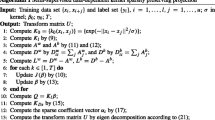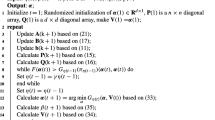Abstract
Dimensionality reduction (DR) methods based on sparse representation as one of the hottest research topics have achieved remarkable performance in many applications in recent years. However, it’s a challenge for existing sparse representation based methods to solve nonlinear problem due to the limitations of seeking sparse representation of data in the original space. Motivated by kernel tricks, we proposed a new framework called empirical kernel sparse representation (EKSR) to solve nonlinear problem. In this framework, nonlinear separable data are mapped into kernel space in which the nonlinear similarity can be captured, and then the data in kernel space is reconstructed by sparse representation to preserve the sparse structure, which is obtained by minimizing a ℓ 1 regularization-related objective function. EKSR provides new insights into dimensionality reduction and extends two models: 1) empirical kernel sparsity preserving projection (EKSPP), which is a feature extraction method based on sparsity preserving projection (SPP); 2) empirical kernel sparsity score (EKSS), which is a feature selection method based on sparsity score (SS). Both of the two methods can choose neighborhood automatically as the natural discriminative power of sparse representation. Compared with several existing approaches, the proposed framework can reduce computational complexity and be more convenient in practice.
Similar content being viewed by others
References
Marcellin M, Gormish M, Bilgin A, Boliek M. An overview of JPEG-2000. In: Proceedings of the 2000 IEEE Data Compression Conference. 2000, 523–541
Elad M, Aharon M. Image denoising via sparse and redundant representations over learned dictionaries. IEEE Transactions on Image Process, 2006, 15(12): 3736–3745
Marial J, Bach F, Ponce J, Sapiro J, Zisserman A. Non-local sparse models for image restoration. In: Proceedings of the 12th IEEE International Conference on Computer Vision. 2009, 2272–2279
Huang K, Aviyente S. Sparse representation for signal classification. In: Proceedings of Advances in Neural Information Processing Systems. 2006, 609–616
Davenport M, Duarte M, Wakin M, Takhar D, Kelly K, Baraniuk R. The smashed filter for compressive classification and target recognition. In: Proceedings of IS&T/SPIE Symposium on Electronic Imaging: Computational Imaging. 2007, 64980H–64980H-12
Donoho D. For most large underdetermined systems of linear equations the minimal l1-norm solution is also the sparsest solution. Communications On Pure and Applied Mathematics, 2006, 59(6): 797–829
Scholkopf B, Smola A, Muller K R. Kernel, principal component analysis. In: Proceedings of the 1997 International Conference on Artificial Neural Networks. 1997, 583–588
Qiao L, Chen S, Tan X. Sparsity preserving projections with applications to face recognition. Pattern Recognition, 2010, 43(1): 331–341
Turk M, Pentland A. Eigenfaces for Recognition. Journal of Cognitive Neuroscience, 1991, 3(1): 71–86
He X F, Niyogi P. Locality preserving projections. In: Proceedings of Advances in Neural Information Processing Systems. 2003, 16: 234–241
Yang Y, Nie F, Xiang S, Zhuang Y, Wang W. Local and global regressive mapping for manifold learning with out-of-sample extrapolation. In: Proceedings of the 24th AAAI Conference on Artificial Intelligence. 2010, 649–654
Belhumeur P N, Hespanha J P, Kriegman D J. Eigenfaces vs. fisherfaces: recognition using class specific linear projection. In: Proceedings of the 1997 IEEE Transactions on Pattern Analysis and Machine Intelligence. 1997, 19(7): 711–720
Xu D, Yan S C, Tao D C, Lin S, Zhang H J. Marginal fisher analysis and its variants for human gait recognition and content based image retrieval. In: Proceedings of the 2007 IEEE Transactions on Image Processing. 2007, 16(11): 2811–2821
Li H F, Jiang T, Zhang K S. Efficient and robust feature extraction by maximum margin criterion. In: Proceedings of the 2006 IEEE Transactions on Neural Networks. 2006, 17(1): 157–165
Liu J, Chen S C, Tan X Y, Zhang D Q. Comments on “Efficient and robust feature extraction by maximum margin criterion”. In: Proceedings of the 2007 IEEE Transactions on Neural Networks. 2007, 18(6): 1862–1864
Zhang D Q, Zhou Z H, Chen S C. Semi-supervised dimensionality reduction. In: Proceedings of the 2007 International Conference on Data Mining. 2007, 629–634
Cai D, He X F, Han J W. Semi-supervised discriminant analysis. In: Proceedings of the 11th IEEE International Conference on Computer Vision. 2007, 1–7
Sugiyama M, Ide T, Nakajima S, Sese J. Semi-supervised local fisher discriminant analysis for dimensionality reduction. Machine Learning, 2008, 78(1–2): 35–61
Qiao L, Zhang L, Chen S. Dimensionality reduction with adaptive graph. Frontiers of Computer Science, 2013, 7(5): 745–753
Bishop C M. Neural Networks for Pattern Recognition. Oxford: Oxford University Press, 1995
He X, Cai D, Niyogi P. Laplacian score for feature selection. In: Proceedings of the Advances in Neural Information Processing Systems. 2005, 17: 507–514
Liu M X, Sun D, Zhang D Q. Sparsity score: a new filter feature selection method based on L1 graph. In: Proceedings of the 21st International Conference on Pattern Recognition. 2012, 11–15
Yang Y, Ma Z, Hauptmann A, Sebe N. Feature selection for multimedia analysis by sharing information among multiple tasks. In: Proceedings of the 2013 IEEE Transactions on Multimedia. 2013, 15(3): 661–669
Ma Z, Nie F P, Yang Y, Uijlings J R R, Sebe N. Web image annotation via subspace-sparsity collaborated feature selection. In: Proceedings of the 2012 IEEE Transactions on Multimedia. 2012, 14(4): 1021–1030
Yang Y, Shen H T, Ma Z, Huang Z, Zhou X F. ℓ2,1-norm regularized discriminative feature selection for unsupervised learning. In: Proceedings of the 22nd International Joint Conference on Artificial Intelligence. 2011(2): 1589–1594
Zhang D, Chen S, Zhou Z. Constraint score: a new filter method for feature selection with pairwise constraints. Pattern Recognition, 2008, 41(5): 1440–1451
Zhao Z, Liu H. Semi-supervised feature selection via spectral analysis. In: Proceedings of the 7th SIAM International Conference on Data Mining. 2007, 641–646
Gao S, Tsang I W H, Chia L T. Kernel sparse representation for image classification and face recognition. In: Proceedings of the 11th European Conference on Computer Vision. 2010, 1–14
Zhang L, Zhou W, Chang P, Liu J, Yan Z, Wang T, Li F. Kernel sparse representation-based classifier. In: Proceedings of the 2012 IEEE Transactions on Signal Processing. 2012, 1684–1695
Yin J, Liu Z, Jin Z, Yang W. Kernel sparse representation based classi-fication. Neurocomputing, 2012, 77(1): 120–128
Chen Y, Nasser N M, Tran T D. Hyperspectral image classification via kernel sparse representation. In: Proceedings of the 2013 IEEE Transactions on Geoscience and Remote Senseing. 2013, 51(1): 217–231
Xiong H, Swamy M N S, Ahmad M O. Optimizing the kernel in the empirical feature space. In: Proceedings of the 2005 IEEE Transactions on Neural Networks. 2005, 16: 460–474
Wang Z, Chen S, Sun T. MultiK-MHKS: a novel multiple kernel learning algorithm. In: Proceedings of the 2008 IEEE Transactions on Pattern Analysis and Machine Intelligence. 2008, 30(2): 348–353
Donoho D. Compressed sensing. In: Proceedings of the 2006 IEEE Transactions on Information Theory. 2006, 52(4): 1289–1306
Shawe-Taylor J, Cristianini N. Kernel Methods for Pattern Analysis. Cambridge: Cambridge University Press, 2004
Martinez M, Kak A C. PCA versus LDA. In: Proceedings of the 2001 IEEE Transactions on Pattern Analysis and Machine Intelligence. 2001, 23(2): 228–233
Wright J, Yang A, Sastry S, Ma Y. Robust face recognition via sparse representation. In: Proceedings of the 2009 IEEE Transactions on Pattern Analysis and Machine Intelligence. 2009, 31(2): 210–227
Tsang I, Kocsor A, Kwok J. Efficient kernel feature extraction for massive data sets. In: Proceedings of the 12th ACM SIGKDD International Conference on Knowledge Discovery and DataMining. 2006, 724–729
Yuan M, Lin Y. Model selection and estimation in regression with grouped variables. Journal of the Royal Statistical Society: Series B (Statistical Methodology), 2006, 68(1): 49–67
Liu J, Ye J. Moreau-yosida regularization for grouped tree structure learning. In: Proceedings of Advances in Neural Information Processing Systems. 2010, 23: 1459–1467
Jacob L, Obozinski G, Vert J P. Group lasso with overlap and graph lasso. In: Proceedings of the 26th ACM International Conference on Machine Learning. 2009, 433–440
Author information
Authors and Affiliations
Corresponding author
Additional information
Zhisong Pan received his BS in computer science and MS degree in computer science and application from PLA Information Engineering University, China in 1991 and 1994 respectively, and his PhD in Department of Computer Science and Engineering, Nanjing University of Aeronautics and Astronautics, China in 2003. From July 2006 to present, he led several key projects of intelligent data processing for the network management. From July 2011, he has working as a full professor in PLA University of Science and Technology, China. His current research interests mainly include pattern recognition, machine learning and neural networks.
Zhantao Deng received his BS in communication engineering in 2009 from the University Electronic Science and Technology of China and his MS in computer science in 2012 from PLA University of Science and Technology. Presently, he is an assistant engineer within the Department of Computer Technology in PLA University of Science and Technology, China. His current areas of research interest are in the fields of sparse learning, dimension reduction and time series prediction.
Yibing Wang received his BS and MS from National University of Defense Technology, China in 2006 and 2010 respectively. He is now a PhD student at PLA University of Science and Technology, China. His main research interests include feature selection, multikernel learning, social media networks, and network securities.
Yanyan Zhang received her BS from Xi’an University of Finance and Economics, China in 2007 and her MS in computer science and application from Nanjing University of Aeronautics and Astronautics, China in 2010. Now she is a teaching assistant in PLA University of Science and Technology, China. Her current research interests include face recognition, hyperspectral image classification, and sparse learning.
Rights and permissions
About this article
Cite this article
Pan, Z., Deng, Z., Wang, Y. et al. Dimensionality reduction via kernel sparse representation. Front. Comput. Sci. 8, 807–815 (2014). https://doi.org/10.1007/s11704-014-3317-1
Received:
Accepted:
Published:
Issue Date:
DOI: https://doi.org/10.1007/s11704-014-3317-1




